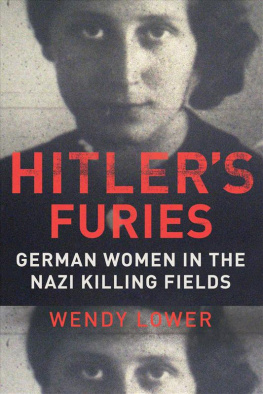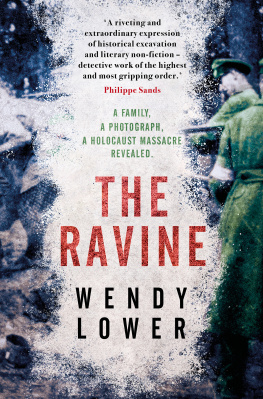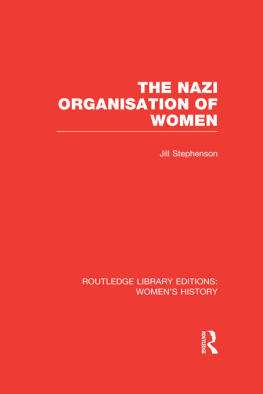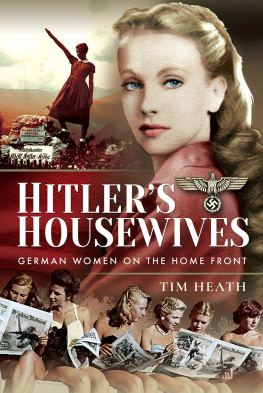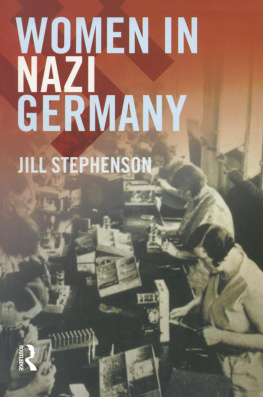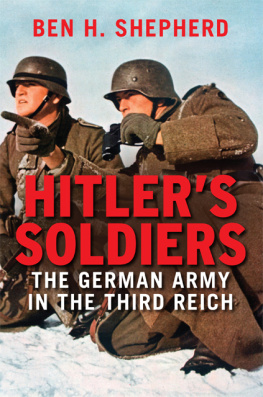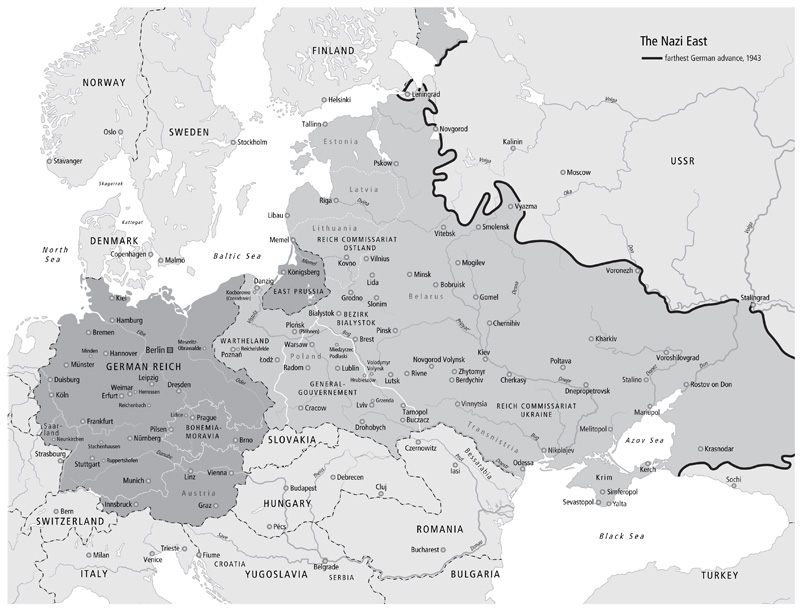Copyright 2013 by Wendy Lower
All rights reserved
For information about permission to reproduce selections from this book, write to Permissions, Houghton Mifflin Harcourt Publishing Company, 215 Park Avenue South, New York, New York 10003.
www.hmhco.com
The Library of Congress has cataloged the print edition as follows:
Lower, Wendy.
Hitlers furies : German women in the Nazi killing fields / Wendy Lower.
pages cm
ISBN 978-0-547-86338-2 (hardback)
1. World War, 19391945Participation, Female. 2. World War, 19391945WomenGermany. 3. Women war criminalsGermany. 4. National socialism and women. 5. Holocaust, Jewish (19391945) I. Title.
D810.W7L69 2013
940.53'18082dc23
2013026081
map Peter Palm, Berlin, Germany
eISBN 978-0-547-80741-6
v2.1013
For my grandmothers, Nancy Morgan and Virginia Williamson
my mother, Mary Suzanne Liljequist
and my sisters, Virginia Lower and Lori Lower
Illustrations
| Page |
| The Nazi East / Peter Palm, Berlin |
| Members of the League of German Girls shooting rifles, 1936 / bpk, Berlin/Art Resource, NY |
| A Nazi Party rally in Berlin, 1935, with a banner declaring, Women and girls, the Jews are your ruin / Courtesy of the United States Holocaust Memorial Museum Photo Archives |
| Red Cross nurses gathered in Berlin / Kurt Friedrich, Courtesy of the Archives of the German Red Cross |
| Erika Ohr, 1941 / Renate Sarkar and Erika Summ |
| Annette Schcking in her nurses uniform, summer 1941 / Courtesy of Annette Schcking-Homeyer and Julie Paulus |
| Ilse Struwe, army staff secretary, at her desk, 1942 / Aufbau Verlag GmbH & Co. KG, Berlin 1999 |
| Liselotte Meier, c. 1941 / Courtesy of the Landesarchiv, Speyer Collection |
| Gertrude Segel, c. 1941 / Courtesy of U.S. National Archives and Records Administration |
| Photos of Vera Sthli in her SS marriage application, 1942 / Courtesy of U.S. National Archives and Records Administration |
| Photos of Liesel Riedel in her SS marriage application, 1935 / Courtesy of U.S. National Archives and Records Administration |
| Erna Petri in Thuringia, late 1930s / Courtesy of the Bundesarchiv, Berlin |
| Recruitment brochure for resettlement advisors in Poland: German Woman! German Girl! The East Needs You! / Courtesy of the Bundesarchiv, Berlin |
| Nurses at a soldiers relief station / Courtesy of the Archives of the German Red Cross |
| German civilians and officials viewing hanged men, Minsk, 1942 or 1943 / Courtesy of the Bundesarchiv, Berlin |
| Ilse Struwe picnicking with colleagues in Ukraine, 1942 or 1943 / Aufbau Verlag GmbH & Co. KG, Berlin 1999 |
| Soldiers home in Novgorod Volynsk / Courtesy of Annette Schcking-Homeyer and Julie Paulus |
| Jews forced to march through Lida before being killed, March 1942 / Courtesy of the Landesarchiv, Speyer Collection |
| A Frau Apfelbaum with a shotgun in the Lida woods / Courtesy of the Landesarchiv, Speyer Collection |
| Einsatzgruppe As coffin-decorated tally of Jews killed in 1941 / United States Holocaust Memorial Museum, courtesy of Thomas Wartenberg |
| Vera and Julius Wohlauf enjoying refreshments, summer 1942, Poland / Courtesy of the Staatsarchiv, Hamburg |
| Erna Petri at her Grzenda estate / Courtesy of the Bundesarchiv, Berlin |
| German female prisoners detained in Kassel, Germany / Courtesy of Yad Vashem |
| Jewish man out of hiding / Courtesy of the Landesarchiv, Speyer Collection |
| Johanna Altvater Zelle in an album used by Israeli investigators / Courtesy of Yad Vashem |
| Arrest photographs of Erna Petri / Courtesy of the Bundesarchiv, Berlin |
Main Characters Witnesses, Accomplices, Killers
INGELENE IVENS , schoolteacher from Kiel, sent to Pozna, Poland
ERIKA OHR , nurse from the village of Stachenhausen in Swabia, daughter of a sheepherder, sent to a hospital in Zhytomyr, Ukraine
ANNETTE SCHCKING , law student from Mnster, great-granddaughter of the esteemed writer Leon Schcking, daughter of a Social Democratic Party politician and journalist, sent as a nurse to a soldiers home in Novgorod Volynsk, Ukraine, and Krasnodar, Russia
PAULINE KNEISSLER , nurse from Duisburg in the Rhineland, born in Odessa, Ukraine, emigrated to Germany at the end of World War I, sent to Poland and Belarus
ILSE STRUWE , secretary from the suburbs of Berlin, went with the German Armed Forces to France, Serbia, and Ukraine
LISELOTTE MEIER , secretary from the town of Reichenbach, Saxony, near German-Czech border, sent to Minsk and Lida, Belarus
JOHANNA ALTVATER , secretary from Minden, Westphalia, daughter of a foundry foreman, went to Volodymyr-Volynsky, Ukraine
SABINE HERBST DICK , secretary from Gestapo headquarters in Berlin, middle-class graduate of a Gymnasium, went to Latvia and Belarus
GERTRUDE SEGEL LANDAU , SS commanders daughter, secretary from Gestapo headquarters in Vienna, volunteered to serve in Radom, Poland, and Drohobych, Ukraine, wife of Einsatzkommando squad leader and Gestapo chief Felix Landau
JOSEFINE KREPP BLOCK , typist who worked in Gestapo headquarters in Vienna and frequently visited her husband, SS major Hans Block, the Gestapo station chief in Drohobych, Ukraine
VERA STHLI WOHLAUF , socialite from Hamburg, wife of Captain Julius Wohlauf, SS and Order Police company commander, Battalion 101, joined her husband in Poland
LIESEL RIEDEL WILLHAUS , typist, daughter of a senior foreman in the ironworks of the industrial Saar region, Catholic-educated, wife of Gustav Willhaus, SS commander of the Janowska concentration camp, joined her husband in Ukraine
ERNA KRBS PETRI , farmers daughter and farmers wife, grammar school education, managed an SS agricultural estate in Ukraine with her husband, SS Second Lieutenant Horst Petri
Introduction
I N THE SUMMER of 1992 I bought a plane ticket to Paris, purchased an old Renault, and drove with a friend to Kiev over hundreds of miles of bad Soviet roads. We had to stop often. The tires blew on the jagged pavement, there was no gas available, and curious peasants and truckers wanted to look under the hood to see a Western automobile engine. On the single highway stretching from Lviv to Kiev, we visited the town of Zhytomyr, a center of Jewish life in the former Pale of Settlement, which during the Second World War had become the headquarters of Heinrich Himmler, the architect of the Holocaust. Down the road to the south, in Vinnytsia, was Adolf Hitlers Werwolf compound. The entire region was once a Nazi playground in all its horror.
Seeking to build an empire to last a thousand years, Hitler arrived in this fertile area of Ukrainethe coveted breadbasket of Europewith legions of developers, administrators, security officials, racial scientists, and engineers who were tasked with colonizing and exploiting the region. The Germans blitzkrieged eastward in 1941, ravaged the conquered territory, and evacuated westward in defeat in 1943 and 1944. As the Red Army reoccupied the area, Soviet officials seized countless pages of official German reports, files of photographs and newspapers, and boxes of film reels. They deposited this war booty and classified the trophy documents in state and regional archives that would remain behind the Iron Curtain for decades. It was this material that I had come to Ukraine to read.
Next page
